When he appears in Nicole Flattery’s recently published novel Nothing Special, Andy Warhol is a spectral presence.
“I never saw him come in but I felt the atmosphere change when he did,” Flattery writes from the watchful point of view of the teenage narrator of the book.
The coming-of-age novel set in the mid 1960s, with some flashes into the present, follows Mae, a lonely teenager who drops out of school after finding herself drawn into the new world of Warhol’s storied Factory in Manhattan. While art and drama and debauchery happen around her among the artist and his acolytes, Mae has the more prosaic job of typist. She is transcribing recordings of conversations that will form the basis of A Novel, Warhol’s (real) experimental book from 1968.
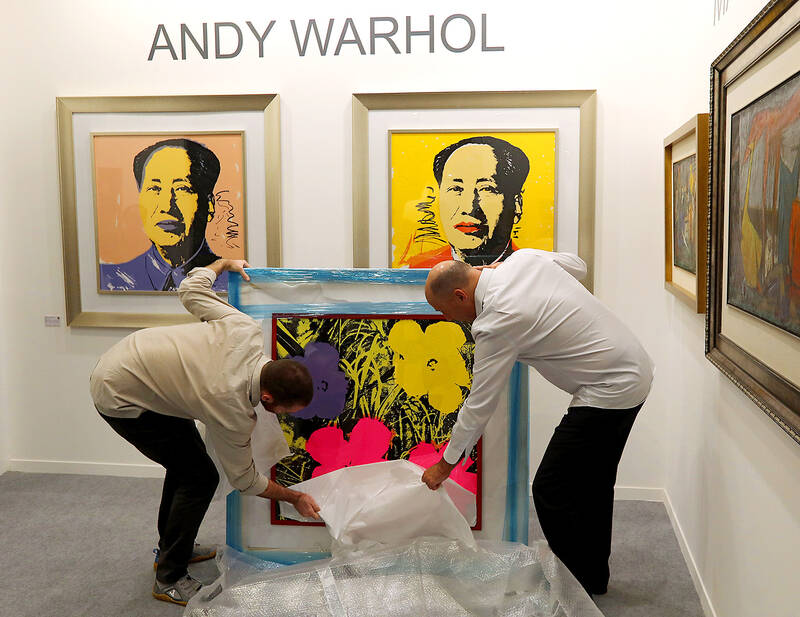
Photo: EPA-EFE
“I feel things work if you just don’t often see that person,” Flattery says of her version of Warhol. “It’s in their interest to remain out of your eyeline. They’ll only have the power if they make themselves like a distant, inaccessible figure.”
Flattery’s reimagining of Warhol might see him as distant, but 36 years after his death, he is ever-present in the public’s imagination. In fact, the recent obsession with him in theater, film and books can make it seem as though you are never more than a meter away from a Warhol-related event.
Opening on Friday at London’s Fashion and Textile museum is Andy Warhol: The Textiles, a survey of his lesser-seen textile designs made in his time as a successful commercial artist in the 1950s and early 60s. In April, the Fondation Louis Vuitton in Paris will launch a show of the mid-1980s paintings he made with Jean-Michel Basquiat. Last year The Collaboration, Anthony McCarten’s play, which premiered at the Young Vic and later transferred to New York, explored the relationship between the two artists — a film version, directed by Kwame Kwei-Armah, is in the works.
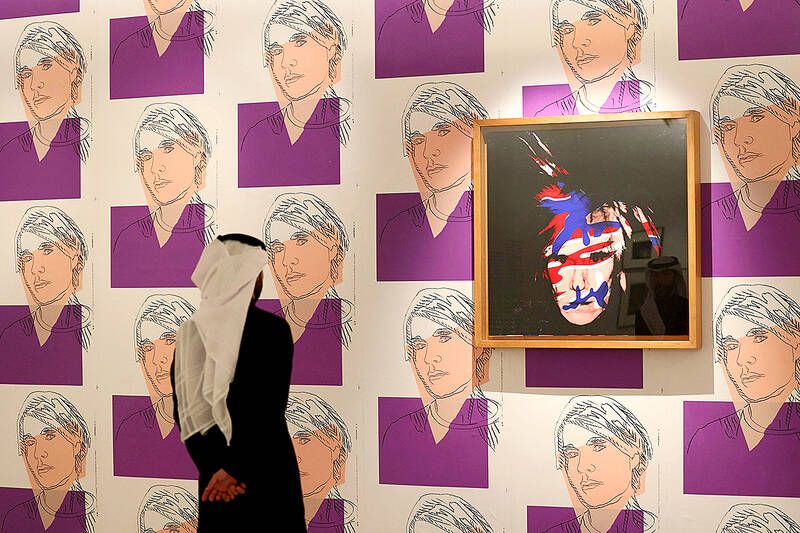
Photo: AFP
Last year also brought a high-profile six-part documentary series on Netflix made by Ryan Murphy, based on Warhol’s diaries, which were published posthumously in 1989. At last September’s New York fashion week, Tommy Hilfiger’s catwalk show was indebted to the artist. Perhaps we are seeing the long tail of his incessant industriousness and boundless influence.
“Warhol is omnipresent. Somehow he seems to, in this digital, Internet age, strike a chord with people,” says Richard Chamberlain, co-curator of the textiles exhibition, and co-author of the book Pop: Design, Culture, Fashion 1956-1976. “I think his subject matter, although it can be quite deep and thought-provoking, is quite accessible. And there’s so much about the man and what he was involved with, which is interesting to people.”
Flattery says that she was particularly influenced by the artist’s experimental films from the 1960s. The Hilfiger fashion week show also called on the Factory years, with broader nods to Warhol’s silver clouds installation, his superstar muses and his nous for branding. The pair were friends in the 1980s — “you could say it is a meeting of preppy minds” Hilfiger said in September.
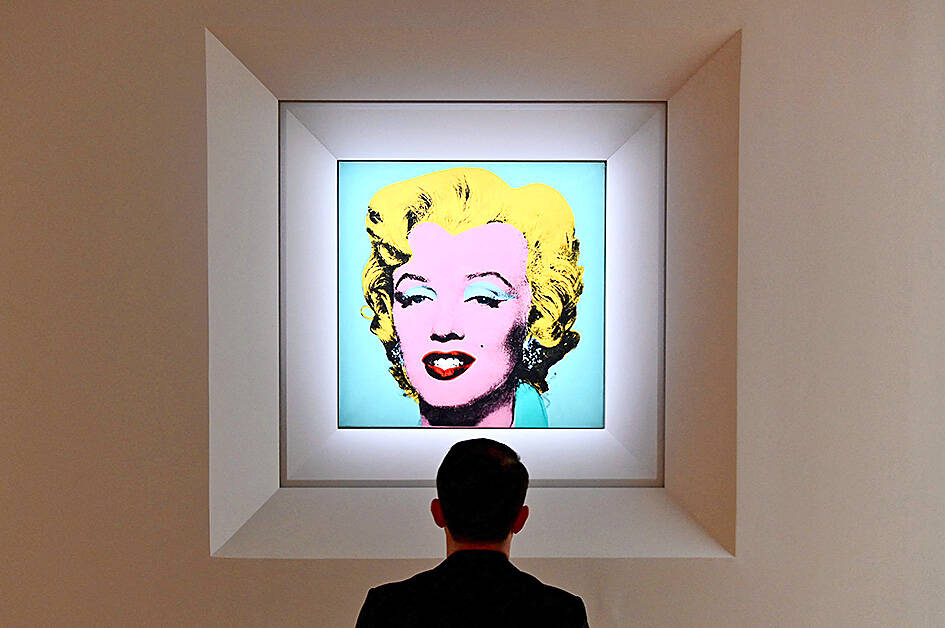
Photo: AFP
Anything that draws on the Factory is immediately evocative of the era. It was in the mid-1960s when a Warhol look first solidified in the public consciousness: jeans and a Breton or black top, with a leather jacket and sunglasses, all presented with an inscrutable gaze.
The move away from the homogeneity of the 1950s into an outfit of the counterculture isn’t unique to Warhol.
“To me, it’s a perennial popularity of mid-1960s bohemian modernist style,” says Nathanial Weiner, lecturer in cultural studies at Central Saint Martins, London. “People really liked that era, because it’s sort of the pinnacle, almost of western casual dress.”
After he was shot by Valerie Solanas in 1968, Warhol withdrew from some of the free-wheeling aspects of the Factory, and honed his outfits into a more toned-down uniform of blue jeans and shirt, blazer and tie. It managed to seem both unremarkably plain, yet uniquely Warholian. Andy the worker. His life and work started to revolve around more established versions of celebrity, rather than around his own creations.
By the 1980s Warhol was often clad all in black, in jeans, polo neck and a jacket, with New Balance or white Reebok Classic trainers. Ever more rake-thin and with his silver-blonde wig at its most shocking, this is a stark vision of Warhol — perhaps indicative of a scramble for relevancy in his friendship with then up-and-coming art star Jean-Michel Basquiat.
This latter look, particularly the hair, has become a signifier of Warhol. It is the version that actor Paul Bettany plays in The Collaboration. David Bowie performed it in Julian Schnabel’s 1996 Basquiat biopic.
“I really didn’t want him to overshadow the book,” says Nicole Flattery of Nothing Special. “I could go back through the appearances of Andy Warhol in films: he’s in the film The Doors [played by Crispin Glover] and Factory Girl [played by Guy Pearce]. I feel with a presence like that, if you don’t get it fully right it can really mess up everything.”
It’s not just his look but also his personal life that seems to continue to capture people’s imagination.
“I thought that the recent mini-series, The Andy Warhol Diaries, was very interesting,” says Scott King, a graphic designer and creator of The Debrist Manifesto, a book on art-world failure and the pursuit of perfectionism.
“It showed him as an active participant in love and disappointment and — quite boring-looking — weekends away in the Hamptons. It humanized him and showed a tenderness, a sadness. I mean, the best work he made was incredibly melancholic wasn’t it? But we don’t usually associate him with tenderness.”
But, as photographer Nat Finklestein’s 1999 book The Factory Years displays, Warhol and his 1960s coterie had already long since created a vision of indelible debauched cool.
“The Warhol stance,” Chamberlain says, “the very sort of hip, Velvet Underground attitudes, that is still very refreshing, and very vital to people. I think there is a Warhol that still has an edginess.”

June 23 to June 29 After capturing the walled city of Hsinchu on June 22, 1895, the Japanese hoped to quickly push south and seize control of Taiwan’s entire west coast — but their advance was stalled for more than a month. Not only did local Hakka fighters continue to cause them headaches, resistance forces even attempted to retake the city three times. “We had planned to occupy Anping (Tainan) and Takao (Kaohsiung) as soon as possible, but ever since we took Hsinchu, nearby bandits proclaiming to be ‘righteous people’ (義民) have been destroying train tracks and electrical cables, and gathering in villages
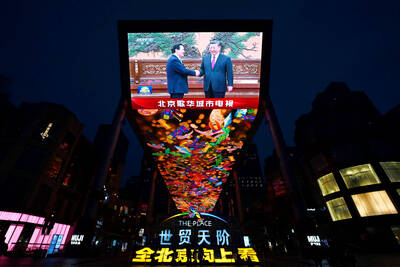
Dr. Y. Tony Yang, Associate Dean of Health Policy and Population Science at George Washington University, argued last week in a piece for the Taipei Times about former president Ma Ying-jeou (馬英九) leading a student delegation to the People’s Republic of China (PRC) that, “The real question is not whether Ma’s visit helps or hurts Taiwan — it is why Taiwan lacks a sophisticated, multi-track approach to one of the most complex geopolitical relationships in the world” (“Ma’s Visit, DPP’s Blind Spot,” June 18, page 8). Yang contends that the Democratic Progressive Party (DPP) has a blind spot: “By treating any
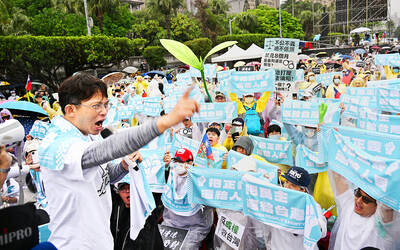
This year will go down in the history books. Taiwan faces enormous turmoil and uncertainty in the coming months. Which political parties are in a good position to handle big changes? All of the main parties are beset with challenges. Taking stock, this column examined the Taiwan People’s Party (TPP) (“Huang Kuo-chang’s choking the life out of the TPP,” May 28, page 12), the Democratic Progressive Party (DPP) (“Challenges amid choppy waters for the DPP,” June 14, page 12) and the Chinese Nationalist Party (KMT) (“KMT struggles to seize opportunities as ‘interesting times’ loom,” June 20, page 11). Times like these can

Swooping low over the banks of a Nile River tributary, an aid flight run by retired American military officers released a stream of food-stuffed sacks over a town emptied by fighting in South Sudan, a country wracked by conflict. Last week’s air drop was the latest in a controversial development — private contracting firms led by former US intelligence officers and military veterans delivering aid to some of the world’s deadliest conflict zones, in operations organized with governments that are combatants in the conflicts. The moves are roiling the global aid community, which warns of a more militarized, politicized and profit-seeking trend